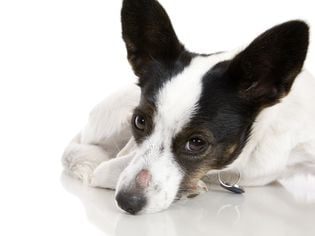Brucellosis is a contagious bacterial disease that can affect many different species, including humans. The specific type of brucellosis that infects dogs causes inflammation in the reproductive organs. Occasionally, the spleen and liver are affected as well. Brucellosis mostly occurs in intact adult dogs, meaning dogs that have not been spayed or neutered.
The most common symptoms of brucellosis are infertility, enlarged scrotum in male dogs, vaginal discharge in female dogs, giving birth to stillborn puppies or miscarrying a pregnancy, and swollen lymph nodes. The disease is unlikely to be of concern if your dog is spayed or neutered, but if you plan on breeding your dog, it is important to know the symptoms and treatment of this canine venereal disease.
What Is Brucellosis?
There are many species of Brucella bacteria. The one that most commonly infects dogs is B. canis. Other species of Brucella tend to infect goats, pigs, cattle, and sheep. In most animals, the infection affects the reproductive system, causing spontaneous abortions, infertility, stillbirths, and inflammation in the reproductive organs.
Once infected with Brucella, it takes roughly three weeks before the bacteria can be detected in the dog's blood. Mostly, it remains localized in the dog's reproductive organs, but occasionally brucellosis affects the dog's spleen or liver. Less often, the eyes, joints, or spine become inflamed. It is fairly common for the disease to cause enlarged lymph nodes, but overall, the infected dog does not appear very ill.
Symptoms of Brucellosis in Dogs
It is quite possible for an owner to be unaware that their dog has brucellosis, as unless the dog is used for breeding, there may not be any obvious symptoms of infection. However, breeders need to remain alert for signs of the disease in their dogs.
Most of the signs of brucellosis are different in males and females since they have different reproductive organs, but swollen or enlarged lymph nodes may be noted in both male and female dogs with this disease.
Male dogs that have not been neutered have a scrotum that contains two testicles. When infected with brucellosis, one of these testicles can become swollen due to inflammation of a part of the testicle called the epididymis. A rash on the scrotum may also be present. In chronic, untreated cases of brucellosis, the testicles may even atrophy or shrink. Finally, a male dog may be infertile due to a Brucella infection.
If an unspayed female dog contracts brucellosis, it may have difficulty getting pregnant or might become infertile. Of those female dogs infected with Brucella that do manage to get pregnant, many will miscarry the fetuses, typically between the 45th and 59th day of the pregnancy. (The average length of a dog's pregnancy is 63 days.) Or the female might give birth to stillborn puppies or puppies that die a few days after birth. Puppies that survive may test positive for brucellosis. Vaginal discharge is usually also seen in a female dog with brucellosis.
Causes of Brucellosis
Infected dogs shed the B. canis bacteria in their semen or vaginal discharge. Smaller amounts of the bacteria are also present in the infected dog's saliva and urine. This makes it easy for another dog to contract the illness, as dogs tend to sniff and lick other dog's genital regions, as well as body fluids such as urine. Dogs can also become infected while mating with a dog that has brucellosis. It is even possible for a dog to catch brucellosis through the mucus membranes of the eyes.
Diagnosing Brucellosis in Dogs
A veterinarian will perform a full physical examination and obtain a history of an intact dog suspected of having brucellosis. A blood sample will be collected and a rapid slide agglutination test (RSAT) will be performed. If this test is negative, it rules out brucellosis. However, if the RSAT is positive, further testing is required. Another type of test called an agar gel immunodiffusion test (AGID) is typically performed if the RSAT is positive. This test is very sensitive for B. canis. Note, however, that the RSAT test cannot detect the presence of the bacteria until at least three weeks has past since the dog became infected.
Veterinarians are required by law to report all positive cases of brucellosis in dogs to their local health agency, as this disease is considered a public health issue.
Treatment
Unfortunately, because brucellosis can be treated with antibiotics, but not eradicated, infected dogs are often euthanized due to the possibility of transmission to humans. If the dog's owner chooses to treat their pet, one or more antibiotics will be given long term and retesting carried out until the dog's results are negative. It is very common for a dog to eventually test positive again, even with antibiotic treatment, however.
The infected dog will need to be kept away from other dogs for the rest of its life and should be kept quarantined on the owner's property. Neutering or spaying an intact dog with brucellosis will also help to decrease how much bacteria it sheds.
Prognosis for Dogs With Brucellosis
Although dogs with brucellosis generally do not appear or act ill, it is impossible to entirely eliminate the bacteria from the dog's body. Because of this, the dog cannot be used for breeding and should be spayed or neutered. It is common for breeders to euthanize dogs with this disease, as the dog will continue to shed the bacteria for the remainder of its life, and thus remains contagious to other dogs and to humans.
How to Prevent Brucellosis
The best prevention for brucellosis is to have your dog spayed or neutered before it reaches puberty. Dogs that are used for breeding, however, should have an RSAT test every three to six months and only be bred if the result is negative. New dogs in breeding kennels should be quarantined for eight to 12 weeks and then tested for brucellosis before being allowed contact with the other dogs at the kennel.
Is Brucellosis in Dogs Contagious to Humans?
Brucellosis is considered to be a zoonotic disease, meaning that infected animals can transmit the disease to humans. Humans most often catch the disease by consuming unpasteurized milk or cheese from infected goats or sheep, but it is possible, although uncommon, for a human to contract brucellosis from a dog.
Unlike brucellosis in animals, humans with the disease most often have flu-like symptoms, including fever, weakness, and weight loss.
Immune-compromised individuals are at the highest risk of contracting B. canis from an infected dog. But despite the low risk for healthy people, gloves should always be worn by any person that is in contact with bodily discharge, fetuses, and the placenta of an infected dog, and proper hand washing techniques should be followed.








